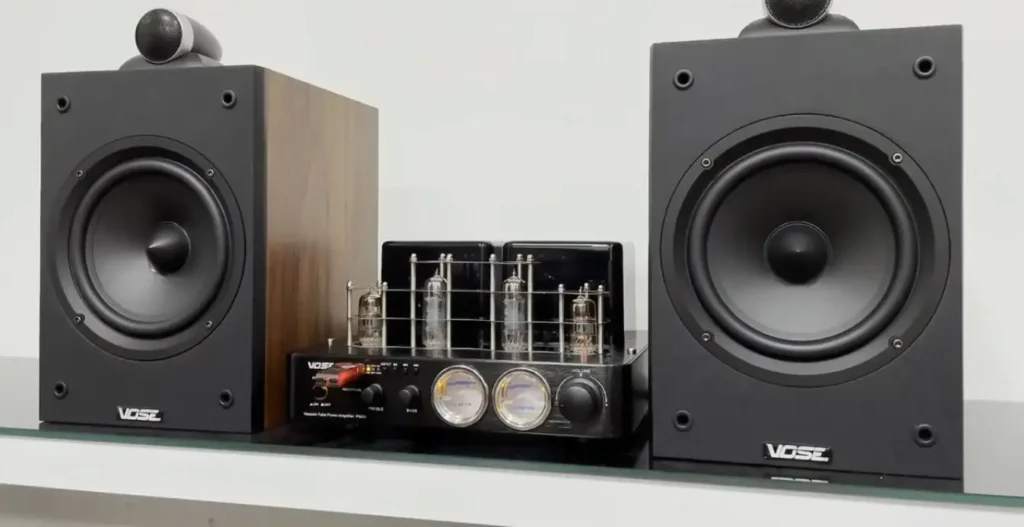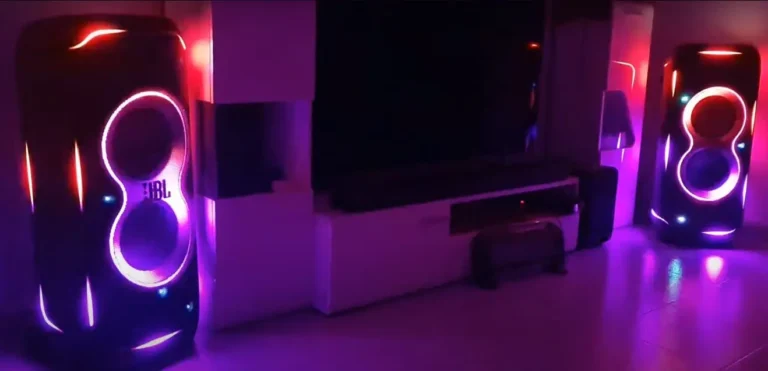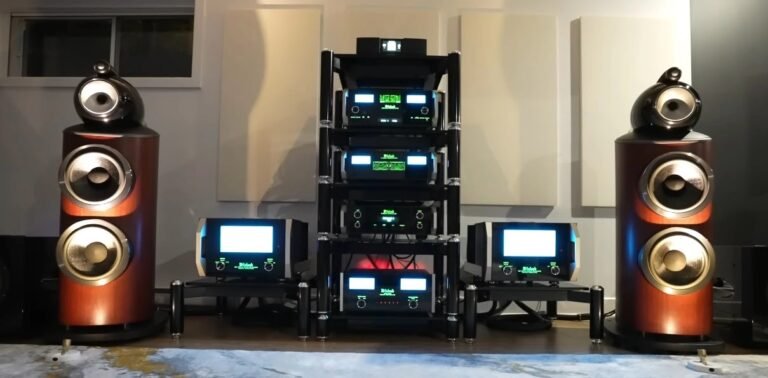HOW TO CHOOSE A SOUND AMPLIFIER?: Complete Guide
One category of people first of all acquires an acoustics, then an amplifier for it, while others start with an amplifier. But in the end, after all, the acoustic system, together with the room where it is installed, produces sound, and the role of the amplifier is to fully reveal the acoustics to which it will be connected.
The amplifier can give a monitor or emotional character to the sound of a particular speaker system. Someone buys a tube amplifier, someone is a transistor, and still others are a hybrid (the input amplifier stage is built on tubes, the final one is on transistors). Here, lamps and transistors are amplifying elements of equipment.
You can also purchase a complete amplifier at once, which is also called integral, where the preliminary amplification path is in one case with the final one, or separately – the preamplifier in one case, the final one in the other. The character and quality of sound are primarily influenced by the preamplifier/amplification stage, while the final one serves as a kind of buffer between the preamplifier and the acoustics, which often also greatly affects the sound quality in the end.
Amplifier First or Speakers First?
The amplifier is super important because it shapes how your music sounds. It can make your speakers sound super accurate and clean, or warm and full of emotion. A lot of this depends on what’s inside, whether it uses tubes (which often sound smooth and rich) or transistors (which can be more precise).
Integrated amps are the most common; they have both the preamp (which picks your inputs and controls the volume) and the power amp (which drives your speakers) in one box.
If you want even better sound, you can go with separate components a preamp and a power amp in two different boxes. The preamp has the biggest effect on the sound’s personality, while the power amp gives your speakers the juice they need to perform their best.
The Great Debate: Tube vs. Transistor Amplifiers
The choice between vacuum tubes and solid-state transistors is a classic debate in the hi-fi world. Each technology has a distinct sonic signature and set of technical characteristics.
Transistor Amplifiers: The Modern Standard
A transistor amplifier, using either bipolar or field-effect transistors (FETs), is known for its high efficiency, reliability, and ease of use.
Key Characteristics:
- High Efficiency: They convert more electricity into sound, running cooler than tube amps.
- High Reliability: Solid-state components are robust and have a very long lifespan.
- Negative Feedback (OOS): To minimize the harmonic distortion, experts always use Negative Feedback (OOS) to keep distortion low and help match the amp to your speakers. This feedback can be local (applied to small sections of the circuit) or general (wrapped around the whole amp).
While Negative Feedback works well, some of the audiophiles and sound experts think that too much general feedback can mess with the sound, adding tiny distortions that might make it less natural. That’s why high-end amps often stick to local feedback; it keeps things clean without over-processing the signal.
Tube Amplifiers: The Vintage Soul
A good tube amplifier is often more expensive and has lower efficiency, but it offers a unique set of advantages that many listeners cherish.
Key Characteristics:
- Simpler Circuitry: Tube circuits are often simpler, which some believe leads to a more direct and pure signal path.
- No General OOS: They typically operate without general negative feedback, which is a major draw for purists.
- Output Transformers: Tube amps require a heavy output transformer to match their high internal resistance to the low impedance of modern speakers. While this adds significant weight and cost, its effect on the sound is often considered more benign than that of OOS. The result is often described as a warm, rich, and “musical” sound.
There are also hybrid amplifiers, which offer a compelling compromise: they use tubes in the preamplifier stage to create a rich tonal character and transistors in the power stage for high efficiency and speaker control.
Why Amplifier Power Matters (More Than You Think)
A common piece of advice is that you can never have too much power, and I agree with that. The sound amplifier must have a significant power reserve for two key reasons:
- Listening at Low Volumes: A powerful amplifier has better control over the speaker drivers even at low volumes, resulting in a fuller, more detailed sound that doesn’t sound “thin.”
- Listening at High Volumes: Ample power provides “headroom,” allowing the amplifier to handle sudden musical peaks (dynamic range) without clipping or distortion. This ensures a clean, effortless sound even when the volume is turned up.
Popular Amplifier Manufacturers to Explore
Listening and comparing are the most important steps. Use as much familiar music as possible and choose the combination of amplifier and speakers that truly connects with you. Here are some respected manufacturers to consider:
- Transistor Amplifiers: Bryston, Burmester, Redgum, Dan D’Agostino, Exposure, upper Denon models, upper Yamaha models, Accustic Arts, Sim Audio, Gato Audio, Plinius.
- Tube Amplifiers: Leben, Audio Research, Air Tight, Conrad-Johnson, Acoustic Masterpiece, Copland.
- Manufacturers in Both Segments: McIntosh, Cary Audio Design.
I especially want to mention Copland and Leben. Tube amplifiers typically have low output power and are best paired with high-sensitivity speakers. Copland is an exception—a marvel of Scandinavian engineering that delivers tube sound with the power to control “heavy,” difficult-to-drive acoustics. Leben is renowned for its minimalist design, featuring the shortest possible signal path, point-to-point wiring without printed circuit boards, and a highly selective element base. Its retro-styled 300 series is compact yet incredibly heavy, a testament to its build quality.
For many, starting with a standout amplifier like one of these and then finding the perfect speakers to match is a very successful path.

What sound amplifier should to choose for Speakers?
The sound amplifier must have a power reserve to comfortably listen at low volumes, as well as at high volumes without distortion. As they say, there is never a lot of power, and I agree with that.
If we talk about a transistor amplifier (the circuit can be built on bipolar or field-effect transistors), it has a higher efficiency than amplifiers whose amplification circuit is built on lamps, high reliability, and ease of use. But there are also features (or disadvantages). In a transistor amplifier, one cannot do without the use of such a circuit solution as OOS (negative feedback), which can be both local and general. This is done to minimize harmonic distortion and to obtain an acceptable output impedance for matching the amplifier to the speaker system. By using high-quality transistors, you can avoid the use of a common OS and use only local OSs, since common feedback introduces into the signal larger values than local intermodulation distortions.
Frequently Asked Questions (FAQ)
1. How much power do I need for my speakers? Check your speaker’s sensitivity rating (in dB) and impedance (in ohms). A speaker with high sensitivity (e.g., >90 dB) needs less power than one with low sensitivity (e.g., <86 dB). A good rule of thumb is to get an amplifier with power output rated at least 50% higher than your speaker’s continuous power handling recommendation to ensure ample headroom.
2. What’s better, a tube or transistor amplifier? Neither is definitively “better”—it’s a matter of personal preference. Transistor amps are generally more accurate, powerful, and reliable. Tube amps are often described as warmer, more musical, and three-dimensional. The best way to decide is to listen to both types with speakers similar to your own.
3. Should I buy an integrated amplifier or separates (preamp/power amp)? For most people, a high-quality integrated amplifier offers the best balance of performance, convenience, and value. Separates are a step up, offering better performance by isolating the sensitive preamp circuits from the high-current power amp, and they provide more flexibility for future upgrades.
4. Why are good amplifiers so heavy? Weight is often an indicator of quality. In both tube and transistor amps, a large, heavy power supply with a massive transformer is needed to provide stable, clean current to the amplification circuits. In tube amps, the output transformers add significant extra weight.
Conclusion: Trust Your Ears
In the End, I can say that technical specifications and brand reputation can only guide you so far. But before taking the final decision, you should listen to it with your ears. The role of the amplifier is to connect you with the music emotionally. Take your time, try multiple amplifiers with your favorite music, and choose the one that, as they say, you “lay on your heart.”







